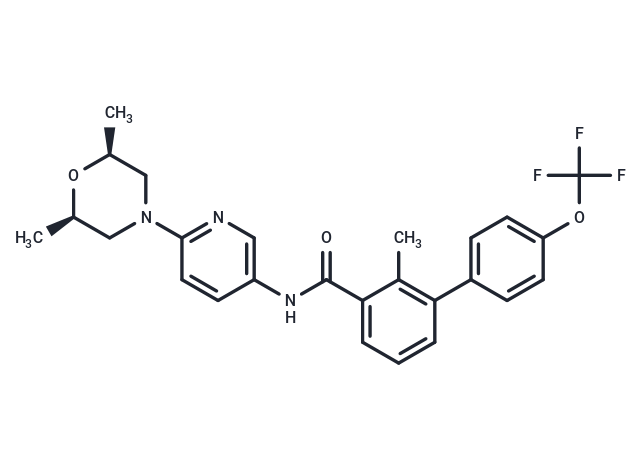Shopping Cart
- Remove All
 Your shopping cart is currently empty
Your shopping cart is currently empty

Sonidegib (Erismodegib), a Smoothened (Smo) antagonist, inhibits Hedgehog (Hh) signaling with IC50 of 1.3 nM (mouse) and 2.5 nM (human), respectively.

| Pack Size | Price | Availability | Quantity |
|---|---|---|---|
| 5 mg | $54 | In Stock | |
| 10 mg | $76 | In Stock | |
| 25 mg | $118 | In Stock | |
| 50 mg | $164 | In Stock | |
| 100 mg | $274 | In Stock | |
| 1 mL x 10 mM (in DMSO) | $58 | In Stock |
| Description | Sonidegib (Erismodegib), a Smoothened (Smo) antagonist, inhibits Hedgehog (Hh) signaling with IC50 of 1.3 nM (mouse) and 2.5 nM (human), respectively. |
| Targets&IC50 | Smo (mouse):1.3 nM, Smo (human):2.5 nM |
| In vitro | The PAMPA experiment revealed that LDE225 possesses a permeability of up to 90.8%. In gradient dilution tests across clinical species, LDE225 demonstrated high oral bioavailability, with biological efficacy ranging from 69% to 102%. LDE225 is weakly basic (pKa: 4.20) and exhibits relatively poor water solubility. The compound shows dose-dependent antitumor activity. It strongly binds to plasma proteins in rats, mice, and humans (>99%), and exhibits binding capacities of 77% and 85% with dog and monkey plasma proteins, respectively. In the Rip1-Tag2 mouse model, LDE225 significantly reduced tumor volume by 95.7%. Administered at a dosage of 5 mg/kg/day, it significantly inhibited tumor growth, equivalent to a 33% T/C value. At dosages of 10 or 20 mg/kg/day, LDE225 achieved tumor regression effects of 51% and 83%, respectively. The inhibition of Gli1 mRNA is associated with the contact between the tumor and plasma mediated by LDE225. In an animal model with tumor transplantation, LDE225 was able to cross the blood-brain barrier and inhibit tumor growth after four days of treatment. |
| In vivo | LDE 225 (0.6-0.8 μM) inhibits the TM3 fluorescent reporter cell line, which has been treated with Hh agonists Ag1.5 ranging from 1 nM to 25 nM. |
| Cell Research | LDE225 is prepared for assay by serial dilution in DMSO and then added to empty assay plates. TM3Hh12 cells (TM3 cells containing Hh-responsive reporter gene construct pTA-8xGli-Luc) are cultured in F12 Ham's/DMEM (1:1) containing 5% horse serum, 2.5% fetal bovine serum (FBS), and 15 mM HEPES, pH 7.3. Cells are harvested by trypsin treatment, resuspended in F12 Ham's/DMEM (1:1) containing 5% horse serum and 15 mM HEPES, pH 7.3, added to assay plates, and incubated with LDE225 for approximately 30 min at 37 °C in 5% CO2. Then 1 nM or 25 nM Ag1.5 is added to assay plates and incubated at 37 °C in the presence of 5% CO2. After 48 hours, either Bright-Glo or MTS reagent is added to the assay plates and luminescence or absorbance at 492 nm is determined. IC50 values, defined as the inflection point of the logistic curve, are determined by nonlinear regression of the Gli-driven luciferase luminescence or absorbance signal from MTS assay vs log10 (concentration) of LDE225 using the R statistical software pack (Only for Reference) |
| Alias | NVP-LDE225, LDE225, Erismodegib |
| Molecular Weight | 485.5 |
| Formula | C26H26F3N3O3 |
| Cas No. | 956697-53-3 |
| Smiles | CC1=C(C=CC=C1C(NC=2C=CC(=NC2)N3C[C@@H](C)O[C@@H](C)C3)=O)C4=CC=C(OC(F)(F)F)C=C4 |
| Relative Density. | 1.255 g/cm3 |
| Storage | store at low temperature | Powder: -20°C for 3 years | In solvent: -80°C for 1 year | Shipping with blue ice. | |||||||||||||||||||||||||||||||||||
| Solubility Information | DMSO: 90 mg/mL (185.38 mM), Sonication is recommended. Ethanol: 90 mg/mL (185.38 mM), Sonication is recommended. H2O: < 1 mg/mL (insoluble or slightly soluble) | |||||||||||||||||||||||||||||||||||
Solution Preparation Table | ||||||||||||||||||||||||||||||||||||
DMSO/Ethanol
| ||||||||||||||||||||||||||||||||||||

Copyright © 2015-2025 TargetMol Chemicals Inc. All Rights Reserved.